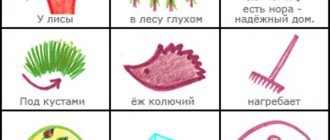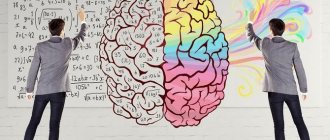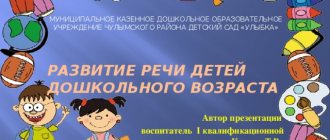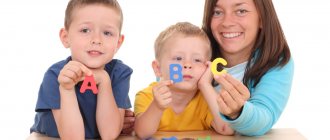- home
- Speech development
The formation and active development of the level of coherent speech for preschoolers requires not only the increased attention of both parents, but also specialized classes that can be conducted in a playful or theatrical form, which is especially attractive to children. In the process of working with children, speech therapists and teachers use many modern techniques, among which mnemonics stands out, aimed at actively developing the level of coherent speech and memory in preschool children.
What is mnemonics
Mnemonics for increasing the level of speech development is a set of techniques aimed at improving perception with memorization of various information using sound samples and visual illustrations.
Provided that classes are carried out systematically, mnemonics for speech development allow you to:
- improve the memorization of heard texts in the form of stories, fairy tales, etc.;
- transform visually acquired data into abstract (and vice versa);
- create logical chains of events;
- Expand words knowledge;
- stimulate the development of imagination and thinking;
- develop children’s ability to compose complex sentences of a descriptive type, which include many words.
Mnemonics, as one of the most effective methods of memorization, is actively used not only by speech therapists, but also by teachers in kindergartens and other preschool institutions.
There are no age restrictions for classes, but many specialized experts recognize the age of 4-5 years as the most optimal, when children already have a fairly rich and varied stock of words and phrases that they can actively use.
The main tool that is used in mnemonics for developing the level of coherent speech in preschool children are mnemonic tables - specific diagrams in which certain information data is embedded.
Mnemonic diagrams for the little ones should be painted in bright shades so that the image that a frog is green, a chicken is yellow, etc. is imprinted in their minds.
For older children, it is preferable to use single-color schemes that do not distract attention, distracting them with additional, and often unnecessary, details.
Automation of the “S” sound in stories. Mnemonic tracks:
SCOOTER
Sanya has a new scooter. Sanya thinks: “I’ll stand on the scooter, the scooter will take me for a ride. That’s why he’s a scooter!” Sanya puts his foot on the scooter, but the scooter doesn’t move or roll Sanya anywhere.
Denis rides past on his scooter. “Yeah, that’s the way to go!” - Sanya thinks. And Sanya rushed off on his scooter into the shady garden.
DOG JAY IN THE FOREST
Stas has a dog, Soyka. On Saturday Stas and Soyka go to the forest. In the forest, Stas lets the dog off the leash. The jay runs through the bushes and sniffs tracks. Here is the fox's trail. The dog follows the trail, but finds not a fox, but an owl. An owl sits on a pine tree and sleeps. A jay stands under a pine tree and thinks about how to get the owl. But the owl sits high, and dogs cannot fly.
Stas whistles to Soyka. We must go home. Goodbye, owl!
Automation of the “S” sound in stories will be more successful if they are repeated several times a day in a playful way.
Areas of use of mnemonic tables
Mnemonic tables for the formation and development of coherent speech (developmental and educational) are images of textual information that is previously divided into groups of words in sequential order. There is one illustration for each group of words. Thanks to such a schematic sketch of information, the baby easily perceives it, remembering everything without much effort.
Using mnemonic tables for speech development, the following is carried out:
- Memorizing fairy tales or rhymes. Young children take part with great interest in educational games based on fairy tales they know. At home, you can invite your child to tell a story to his favorite toy, using a series of pictures. You can also draw a mnemonic table together, depicting the heroes of events with your own invented symbols, for example, a triangle is a person, a wavy line is a cloud in the sky. Thus, not only the formation of coherent speech occurs, but also the active development of imagination and fantasy with the manifestation of the hidden creative abilities of children.
- Learning general rules, such as how to brush your teeth correctly. The diagrams depict the sequence of all manipulations that are easily perceived and remembered.
- Compiling stories describing objects, events, pets, etc. Focusing on pictures that answer basic questions: who is it, what color is it, what sounds does it make, what does it like to eat, etc., children can create a consistent description.
- Working on a retelling. After reading the text, the most difficult words are highlighted, the meaning of which must be explained to the child. After the explanations, a conversation should be held on the entire content of the text with a demonstration of drawings from the mnemonic table. A joint retelling using pictures will allow the child to quickly remember information and tell the story he heard himself.
- Solving riddles. With the help of mnemonic tables, children learn to identify an exact object, focusing on its characteristics. At the first stage, it is necessary to explain to the child everything that is depicted in each picture, and only after that offer to independently guess the encrypted object.
Speech therapy classes on the development of coherent speech using a variety of mnemonic diagrams involve memorizing and deciphering the plot illustrations given in the table. The type and thematic content of mnemonic tables can be different; execution can be printed (Doman cards) or made by hand. Cards for speech development in the first lessons should be small with light storylines; it is recommended to place 3-4 of them in one row, in this position they are easier to perceive.
Articulation gymnastics before classes
Automation of the sound “R” in words begins with the preparation of the muscles of the speech apparatus. Articulation gymnastics are widely used for this purpose. Pre-warmed muscles help you cope with incorrect pronunciation faster and more successfully.
- The first exercise is called “Naughty Tongue”. To perform it, you should smile with your mouth open, place your tongue on your lower lip, biting it slightly with your teeth. In this position, you need to say: “five-five-five” for 10 seconds.
- Second lesson “Shovel”. It is done this way: you need to open your mouth, smiling, put a wide tongue on your lower lip and fix this state for 5 seconds. You will need to do this 3 times.
- The third good exercise is the Turkey Punch. The child will need to open his mouth, smile and move the wide front edge of the tongue back and forth across his upper lip. In this case, you cannot tear yourself away from your lip, and bend the tip slightly upward. You should start the exercise slowly and then gradually increase the speed of movements.
How to create mnemonic tables
Drawing up mnemonic tables involves performing the following manipulations:
- breaking the text into parts (focusing on the most important points);
- dividing a sheet of paper into squares (the number of squares depends on the highlighted parts of the story);
- depiction of each moment in the picture (both nouns and adjectives can be described);
- words that are difficult to sketch (verbs or questions) can be depicted as a “?” (the child must comment on them).
To facilitate the perception of fairy tales or riddles by young children, the works are broken down into individual situations, which are subsequently transferred to pictures for children.
Features of use
When practicing in the form of a game with mnemonic tables, children are asked to:
- review speech therapy cards;
- remember what is described;
- talk about what you saw, focusing on the pictures.
When children use mnemonics and perform assigned tasks, they actively carry out the following processes:
- viewing diagrams and understanding what you see;
- transformation of visual data into figurative data, identification of what is seen with a concept;
- compiling a story based on drawings;
- memorizing fairy tales, stories, etc.
Older preschoolers can themselves take part in compiling mnemonic tables, focusing on the words of the teacher, who broke the story (fairy tale, riddle) into situations, explaining what needs to be drawn. The simplest and most interesting option is to depict a mnemonic table on the theme of the seasons (summer, winter, etc.) or based on fairy tales (best of all, your favorite ones).
The development of children's coherent speech in older preschool age is also possible and necessary at home (at any time convenient for parents and the baby). This can help:
- joint reading of books with fairy tales, equipped with bright illustrations, reciting the main points and highlighting key characters and events;
- regular use of fiction as an effective means for increasing the level of development of coherent speech;
- a large book with tasks and exercises aimed at the active development of a child’s coherent speech (can be purchased in the children’s educational literature department of any bookstore);
- Doman cards;
- methodological recommendations for the development of coherent speech; other methods at the discretion of parents and the advice of teachers and speech therapists.
Mnemonic tables for children with OHP
The concept of coherent speech and its significance for the development of a child with general speech underdevelopment (GSD) has a direct relationship with the logic of thinking and the ability to comprehend images seen or sounds heard, expressing this in sequential speech in which logical chains are present. The general level of development of coherent speech inherent in preschoolers with ODD depends on the ability to think through information and construct statements on a variety of topics.
Dialogical speech is displayed in the communication of several people, often accompanied by simple monosyllabic statements, asking specific questions and composing options for answers to the interlocutor’s questions, followed by reproduction of the selected answer. In this process, a special role is played by formulating and asking questions, constructing answers and reasoned defense of one’s opinion. Coherent monologue speech in preschoolers is characterized by expansion and concentration of thoughts on the main thing, without delving into details. In the process of reproducing one’s thoughts and choosing linguistic means, internal motives play a decisive role, since it is they that stimulate monologue speech.
The features of the stages of development of coherent monologue and dialogic speech vary, but both types are closely interrelated. This nuance must be taken into account when conducting classes aimed at stimulating the development of coherent speech in children with ODD.
The introduction of mnemonics into speech development classes for preschool children should be carried out with the help of mnemonic squares, in which the simplest words are encrypted (boy, girl, sun). Only after children understand the concept of “encryption” can they move on to more difficult variants of schemes - mnemonic tracks with mnemonic tables, which can be based on a whole story.
Mnemonic track “Two funny geese”.
Using this technique during classes with children with special needs allows:
- increase attention and interest in games with logic cards;
- facilitate the perception and processing of information data that
- are stored in memory and can be played back if necessary.
Using mnemonics in speech therapy classes.
“Teach a child some five words unknown to him - he will suffer for a long time and in vain, but associate twenty such words with pictures, and he will learn them on the fly.” K.D. Ushinsky
The problem of developing coherent speech remains relevant in modern didactics. The further development of the child and his acquisition of educational knowledge in the school education system depend on the degree of development of the skills of coherent speech. Mastery of coherent monologue speech is the highest achievement of children's speech development. It includes the development of the sound side of the language, vocabulary, grammatical structure of speech and occurs in close connection with the development of all aspects of speech - lexical, grammatical, phonetic. Coherent speech reflects the logic of the child’s thinking, his ability to comprehend what he perceives and express it correctly. By the way a child constructs his statements, one can judge the level of his speech development. The formation of coherent speech includes the development of skills to construct statements of different types: description (the world in statics), narration (the dynamics of events in motion and time), reasoning (establishing cause-and-effect relationships). Today, figurative speech, rich in synonyms, additions and descriptions, in children is a very rare phenomenon. problems in children's speech
: • Monosyllabic speech, consisting only of simple sentences. Inability to construct a common sentence grammatically correctly. • Poverty of speech. Insufficient vocabulary. • Use of non-literary words and expressions. • Poor dialogical speech: the inability to formulate a question competently and clearly, or to construct a short or detailed answer. • Inability to construct a monologue: for example, a plot or descriptive story on a proposed topic, retelling the text in your own words. • Lack of logical basis for your statements and conclusions. • Lack of speech culture skills: inability to use intonation, regulate voice volume and speech rate, etc. • Poor diction.
Therefore, pedagogical influence on the development of speech of old and young schoolchildren is a very difficult matter. It is necessary to teach children to express their thoughts coherently, consistently, and grammatically correctly, and to talk about various events from the surrounding life. Considering that at this time children are oversaturated with information, it is necessary that the learning process be interesting, entertaining, and developmental for them. Let's consider the factors that facilitate the process of developing coherent speech.
One of these factors, according to S. L. Rubinshtein, A. M. Leushina, L. V. Elkonin and others, is visibility.
Examining objects and paintings helps children name objects, their characteristic features, and actions performed with them. As a second auxiliary factor, we can highlight the creation of a plan of utterance,
the importance of which was repeatedly pointed out by the famous psychologist L. S. Vygotsky.
He noted the importance of sequential placement of all specific elements of an utterance in a preliminary scheme. Modern psychological and methodological studies note that the skills and abilities of coherent speech during their spontaneous development do not reach the level that is necessary for a child’s full education at school. These skills need to be taught specifically. To be fair, it should be noted that the formation of coherent speech is the most difficult section of remedial training. This problem becomes especially relevant in relation to children with general speech underdevelopment, since the formation of coherent speech in such children occurs at a slow pace and is characterized by certain qualitative features. The purposeful formation of coherent speech
is of utmost importance in the general system of speech therapy work with children with general speech underdevelopment.
This is determined, first of all, by the leading role of coherent speech in the education of children of both senior preschool and school age. The systemic speech underdevelopment observed in children, as a rule, in combination with a lag in the development of a number of mental functions, and especially memory, requires a differentiated approach to the choice of methods and techniques for the formation of coherent speech. Proper organization of education for children with special needs is a very difficult matter. Therefore, along with generally accepted techniques and principles, the use of original, creative methods, the effectiveness of which is obvious, is quite justified. One of these techniques is the use of mnemonic techniques.
To begin with, a parable. In Greece, on the island of Heoss BC, an earthquake occurred, which buried the house of a rich man and the guests who were feasting with the owner in his large house. When people were excavated, it was difficult to determine from their remains who was lying where. The only survivor, teacher of rhetoric and poet Simonides, who left the house shortly before the tragedy, easily remembered who was sitting where and who was doing what. So relatives identified the bodies of their loved ones, and Simonides became the founder of a new method of memorization - topological mnemonics,
according to which, to memorize a large amount of material, it is enough to place it in a familiar space (for example, your own apartment) and retrieve (find) it as needed.
Simonides' teaching consisted of two important concepts: association and background. Association is a mental connection between two objects, background is something that you know well down to the smallest detail. Then, in order to remember many facts, you need to connect (associate) them with what is familiar to you. The Simonidean method was widely used by Cicero, who delivered his speech while walking from room to room. Speaking to the public, he mentally walked the same path, collecting facts and sayings “scattered” along the way. Subsequently, the mnemonic was forgotten for many years. However, the increased amount of information and the need to remember a lot and for a long time revived interest in this area of practical psychology. Currently, many methods of rational memorization have been created, but their essence is still the same - first, some reference row (background) is remembered, to which associations are selected. Mnemonics
, or
mnemonics
, is a system of various techniques that facilitate memorization and increase memory capacity by forming additional associations, organizing the educational process in the form of a game. The use of mnemonics is currently becoming relevant. The main “secret” of mnemonics is very simple and well known. When a person connects several visual images in his imagination, the brain records this relationship. And later, when recalling one of the images of this association, the brain reproduces all previously connected images. It is well known that the language of the brain is images. And, above all, visual images. If we address the brain in its language, it will carry out any of our commands, for example, the “remember” command. But where can we get programs that will allow us to communicate with the brain and encode telephone numbers, dates, car numbers into its figurative language? Mnemonics is such a program. It consists of several dozen mental operations, thanks to which it is possible to “establish contact” with the brain and take under conscious control some of its functions, in particular, the memory function. The use of mnemonic techniques helps to increase memory capacity. All this is achieved through the formation of associations. Abstract objects and facts are replaced by images that have a visual, auditory or kinesthetic representation. Most people have difficulty remembering words with unknown, abstract meanings. Memorized information disappears from memory after a few days. For durable and easy memorization, you should fill the word with content (using mnemonics techniques). Connect it with specific bright visual and sound images, with strong sensations. Mnemonics techniques do not improve memory, they only make memorization easier. We have known many simple mnemonic techniques since school.
K.D. Ushinsky wrote: “Teach a child some five words unknown to him - he will suffer for a long time and in vain, but connect twenty such words with pictures, and he will learn them on the fly.”
Mnemonics techniques for memorizing the colors of the rainbow: red, orange, yellow, green, blue, indigo, violet. There are several mnemonic sayings: Every hunter wants to know where the pheasant is sitting. How once Jacques the city bell-ringer broke a lantern. Every designer wants to know where to download Photoshop
Mnemonics techniques for memorizing the rules of the Russian language:
Mnemonics for memorizing adverbs without b: I can’t bear to get married
Mnemonics for remembering words with s after ts: The gypsy on tiptoe tutted to the chicken: “Tsyts”
Mnemonics to make it easier to remember, in which cases O and E are written under stress after hissing ones: Does the girl have someone else’s brocade shoe? - not good Saves the peppered stew for the night
Mnemonics in pedagogy are called differently: Valentina Konstantinovna Vorobyova calls this technique sensory-graphic schemes
, Tkachenko Tatyana Aleksandrovna -
subject-schematic models
, Glukhov V.P. -
blocks-squares
, Bolsheva T.V. -
collage
, Efimenkova L.N -
scheme for compiling a story
.
This technology has: 1.
Theoretical basis.
It is based on the idea of the complex and active nature of memorization processes. Relying on a number of jointly working apparatuses of the human cerebral cortex, it thereby opens up wide opportunities for more effective memorization of a poetic text, retelling a story heard or read, which is especially important for children with ODD. (V.A. Kozarenko “Textbook of mnemonics “Giordano” memorization system”) 2.
Forms imagination, understanding of what you hear;
the ability to retain received information in memory; 3.
Develops imaginative thinking, creative abilities of children, visual memory.
The purpose of training:
- development of coherent speech;
- transformation of abstract symbols into images (information recoding);
- development of fine motor skills of the hands;
- development of basic mental processes - visual and auditory memory, attention, imagination, associative and figurative thinking;
- Mastering the techniques of working with mnemonic tables helps and reduces training time.
Distinctive features of the technology:
- has a clear theoretical and experimental basis;
- memorization techniques are individualized;
- figurative codes are widely used to ensure quick memorization;
- the concept of “memorization skill” was introduced and a precise system for monitoring memorization skill was developed.
Mnemonic table
- This is a scheme that contains certain information. Common tasks for all types of mnemonic tables:
- Memory development (training in various memorization techniques);
- The ability to analyze, isolate parts, combine into pairs, groups, the whole, the ability to systematize;
- Development of logic;
- Development of imaginative thinking;
- The ability to think coherently, compose stories, recode information;
- Solving didactic and educational problems;
- Development of ingenuity;
- Attention training;
- Skill in correct graphic representation;
Types of mnemonic tables:
- developmental (training of basic mental processes);
- educational;
At our master class, we talk about the peculiarities of using developmental mnemonic tables in speech therapy classes, which are one of the methods for developing coherent speech in older preschoolers and younger schoolchildren with OHP.
What can be depicted in a mnemonic table?
Almost everything can be depicted in a mnemonic table - i.e.
a graphic or partially graphic representation of fairy tale characters, natural phenomena, and some actions is produced, i.e. You can draw whatever you see fit. But depict it in such a way that what is drawn is understandable to children. This technique makes it much easier for children to find and memorize words. The symbols are as close as possible to the speech material, for example, a house is used to designate domestic birds and animals, and a Christmas tree is used to designate wild (forest) animals and birds. Like any work, it is built from simple to complex. Work begins with the simplest mnemonic squares.
This is how work on the word is carried out.
For example, the word “boy” is given, its symbolic designation. Children gradually understand what it means to “encrypt a word.” For 3-5 years old, it is necessary to give colored mnemonic tables, since individual images remain in children’s memory faster: the sun is yellow, the sky is blue, the cucumber is green. Children gradually understand what it means to “encrypt a word.” Then we move sequentially to mnemonic tracks.
Then we move on to step-by-step encoding of word combinations, memorizing and reproducing sentences using conventional symbols.
And later to mnemonic tables.
The number of cells in the table depends on the complexity and size of the text, as well as the age of the child.
Fragment of a subgroup lesson using mnemonic tables in 1st grade on the topic “Automation of the sound [w] in syllables, words, phrases.” Goal:
Automation of sound [w].
Tasks:
Automation of the sound [w] in isolated pronunciation, in syllables, words, phrases, poems, connected speech.
Clarification of correct articulation when pronouncing a sound, its sound characteristics. Equipment:
Diagrams for articulation and sound characteristics of sound [w]. Mnemonic table for a set of exercises for producing hissing sounds. Mnemonic table for automating sound in spoken language and storytelling.
- Articulatory features of sound.
Guys, choose pictures that characterize the position of the articulatory apparatus when pronouncing the sound [w]:
We draw a conclusion
: when we say [w], the lips are rounded, slightly pushed forward, the wide tongue rises to the tubercles behind the upper teeth. The air stream comes out warm. The vocal cords do not tremble, which means the sound is dull.
- Sound characteristics of sound
Guys, remind me of the characteristics of sound (one student comes to the board and shows the desired diagram)
- Articulation gymnastics
Guys, in front of you is a table that will help us perform articulation gymnastics. The speech therapist reads a poem for each articulation exercise.
MEM TABLE
A set of exercises for articulating the sounds Ш, Ж, Ш, Ш
- Automation in syllables
Reading the syllabic table
| LUG NO AL MA AND PKA SA Sh E RY KA O NA KRY Y LOK NA U V LE KAL GAL RA |
Speech therapist:
Ш - a hard deaf consonant, - Will become a friend to you and me.
Let it be SIZZLING, well! Be stricter with him too! Don’t forget, in the syllable SHI I
always write after it! And now the students
Let's read the words with the syllable SHI. (On the board there are pictures under which the words appear, with the syllable SHI highlighted) SHIP, ROSE HIP, AWL, TIRE, WIDTH, OVERCOAT, MACHINE, CHIFONIER, CHIFON, POINTS, REEDS, crumble, elders.
- Automation in plain English
— First, the speech therapist recites a simple phrase, showing pictures sequentially. Then there is a conversation on the content of the pure talk. The speech therapist reads it again, and then each student pronounces the phrase independently.
- Atw
his
Ilya shki
puck
and
stick
. - In the Kama swampw
and, On the lawn
there
was
a shala sh
i. - Uw
ki on the top of the
head
the
cat and the mouse
,
But the cat
’s
ears
are
larger
than the mouse
’s
.
Homework: Learn pure sayings using mnemonic tables. Try to draw a mnemonic table for a pure phrase with the sound [w].
Working on a retelling.
Retelling is an easier type of monologue speech, because he adheres to the author's position of the work, it uses a ready-made author's plot and ready-made speech forms and techniques. This is to some extent reflected speech with a certain degree of independence. A picture-graphic plan in the form of pictograms acts here as a means of mnemonics. Stages of working on the text when retelling: 1. The speech therapist explains to the child the meaning of difficult words. The child repeats them. 2. Reading the text with a demonstration of the plot picture. 3. Conversation on the content of the text. 4. Repeated reading of the text by adults with a focus on retelling based on a mnemonic table. 5. Retelling the story by a child based on a mnemonic table.
Retelling of the story “Hello, winter-winter!”
1. The speech therapist reads the text and demonstrates supporting pictures.
Winter came. White, fluffy snow everywhere. It's cold outside. The children dressed warmly and went for a walk. They went sledding, skiing, played snowballs, and made a funny snowman. Good in winter!
2. Answers to questions based on content.
Questions: What time of year is it? Where is the snow? What kind of snow? What's the weather outside? Where did the children go? How did they dress? What did the children do during the walk? Do children like to go for walks in winter?
3. Repeated reading of the story with the intention of retelling.
4. Retelling the text by the child in his own words.
A retelling of L. Tolstoy’s story “The Bone” based on a mnemonic table.
- The mother bought plums and wanted to give them to the children after lunch. They were still on the plate.
- Vanya never ate plums and kept sniffing them.
- And he really liked them. I really wanted to eat it.
- He kept walking past the plums.
- When there was no one in the upper room, he could not resist, grabbed one plum and ate it. Before dinner, mom counted the plums and saw that one was missing.
- She told her father.
- At dinner, the father says: “What, children, didn’t anyone eat one plum?”
- Everyone said no. Vanya turned red as a lobster and also said: “No, I didn’t eat.”
- Then the father said: “What one of you ate is not good, but that’s not the problem.” The trouble is that there are seeds in plums,
- and if someone does not know how to eat them and swallows a bone. He'll die in a day. I'm afraid of this.
- Vanya turned pale and said: “No, I threw the bone out the window.”
- Everyone laughed, and Vanya began to cry.
Memorizing poetry
Mnemonic tables are especially effective when learning poems
. Using supporting drawings to teach memorizing poems captivates children and turns the activity into a game.
Stages of working on a poem:
- The speech therapist reads the poem expressively.
- The speech therapist reports that the child will learn this poem by heart. Then he reads the poem again using the mnemonic table.
- The speech therapist asks questions about the content of the poem, helping the child understand the main idea.
- The speech therapist finds out which words are incomprehensible to the child and explains their meaning in a form accessible to the child.
- The speech therapist reads each line of the poem separately. The child repeats it using a mnemonic table.
- The child recites a poem based on a mnemonic table.
A mole has climbed into our yard and is digging at the gate. A ton of earth will enter the mouth if the mole opens its mouth. (excavator)
Sly hedgehog
The cunning eccentric hedgehog sewed a prickly jacket, covered in needles, without fasteners. The hedgehog will attach a pear to a needle, a plum - any fruit that he finds under the tree, and with a rich gift he will rush to his hedgehogs. P. Voronko
Working on mnemonic riddles
These are riddles, but not simple ones. When solving these riddles, children learn to identify an object based on the signs described with the help of signs. At the initial stages of training, the speech therapist comments in detail on each drawing. At the next stage, children are asked to look at the encrypted letters, guess what object is hidden there, and explain how they guessed the object on their own. Then the children make up their own “mnemonic riddles” and tell them to other children.
Mnemonic riddle "Jeans"
They come in blue, black or dark blue. They are made from denim. They have a belt and trouser legs. They are worn all year round: in autumn, winter, spring and summer. Both girls and boys wear them.
"Riddle (Mailbox)"
| Blue house | at the gate. | Guess who lives in it. |
| The door is narrow | under the roof | not for squirrels |
| not for mouse. | Through this door | news comes. |
| Half an hour | spend together. | News |
| for a long time | don't sit | they fly in all directions. |
Work on proverbs and sayings
At the end of my speech, I offer you a mnemonic table for the proverb. Guess which one?
It must be emphasized that mnemonic tables are not limited to all work on the development of coherent speech in children. This is, first of all, the initial, “starting”, most significant and effective work, since the use of mnemonic tables allows children to more easily perceive and process visual information, store and reproduce it. Using the mnemonics method in working with children with general speech underdevelopment is an important way to develop coherent speech and an accessible means of understanding the world around them. The presented methods of work make it possible to increase the effectiveness of speech correction for older preschoolers and younger schoolchildren with ODD, helps to increase interest in this type of activity and optimize the process that develops coherent speech in children. They are also a means of forming one of the key concepts - mastery of oral communication, which is so necessary for adaptation in the modern information society.
Used Books:
- Bolshova, T.V. We learn from a fairy tale. Development of preschoolers’ thinking using mnemonics / St. Petersburg, 2005.
- Vorobyova V.K. Methodology for the development of coherent speech in children with systemic underdevelopment / M., 2005.
- Glukhov V.P. Formation of coherent speech in preschool children with general speech underdevelopment Preschool education 2004 - No. 6.
- Gromova O.E., Solomatina G.N., Savinova N.P. Poems about the seasons and games. Didactic materials on the development of speech of children 5 – 6. Moscow, 2005.
- Efimenkova L.N. Formation of speech in preschool children - M., 1985.
- Kudrova T.I. Modeling in teaching literacy to preschoolers with speech underdevelopment Speech therapist in kindergarten 2007 - No. 4.
- Omelchenko L.V. The use of mnemonic techniques in the development of coherent speech Omelchenko L.V. Speech therapist. 2008.- No. 4.
- Tkachenko T.A. Using diagrams in writing descriptive stories. Preschool education. 1990. - No. 10.







